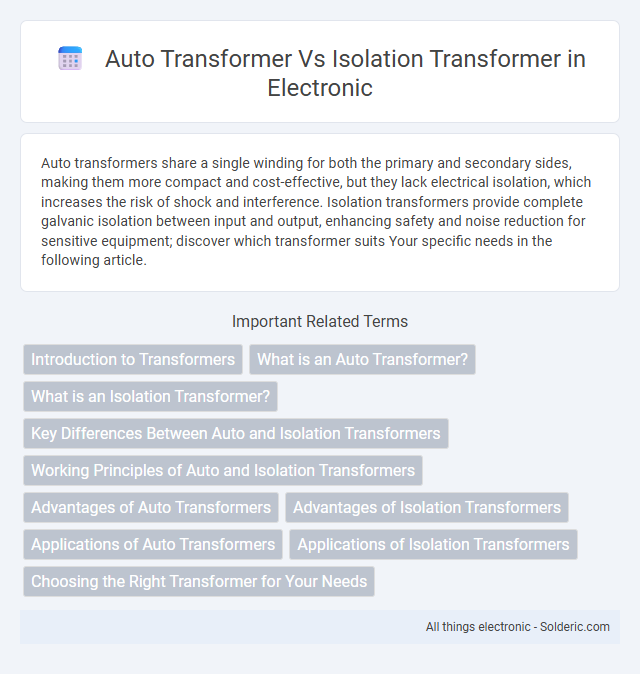Auto transformers share a single winding for both the primary and secondary sides, making them more compact and cost-effective, but they lack electrical isolation, which increases the risk of shock and interference. Isolation transformers provide complete galvanic isolation between input and output, enhancing safety and noise reduction for sensitive equipment; discover which transformer suits Your specific needs in the following article.
Comparison Table
| Feature | Auto Transformer | Isolation Transformer |
|---|---|---|
| Primary Function | Voltage step-up or step-down with a common winding | Electrical isolation between primary and secondary windings |
| Winding Configuration | Single continuous winding acting as both primary and secondary | Separate primary and secondary windings with no electrical connection |
| Cost and Size | More compact and economical | Larger and more expensive |
| Electrical Isolation | No isolation; common winding shares connection | Provides galvanic isolation for safety and noise reduction |
| Efficiency | Higher efficiency due to smaller winding resistance | Lower efficiency compared to auto transformers |
| Applications | Voltage regulation, motor starting, voltage matching | Medical equipment, sensitive electronics, isolation for safety |
| Safety | Less safe for sensitive equipment due to no isolation | High safety standards due to isolation |
Introduction to Transformers
Transformers are electrical devices that transfer energy between circuits through electromagnetic induction, with auto transformers and isolation transformers serving distinct purposes. Auto transformers feature a single winding acting as both the primary and secondary, allowing voltage adjustment with higher efficiency and reduced size but less electrical isolation. Isolation transformers use separate primary and secondary windings to provide galvanic isolation, enhancing safety and reducing noise in sensitive electronic equipment.
What is an Auto Transformer?
An auto transformer is a type of electrical transformer with a single winding that acts as both the primary and secondary winding, allowing voltage adjustment through a sliding contact. It is more compact and efficient for voltage step-up or step-down compared to isolation transformers. Unlike isolation transformers, auto transformers do not provide electrical isolation between the input and output circuits, which impacts their applications in safety-critical environments.
What is an Isolation Transformer?
An isolation transformer is a type of transformer designed to decouple two circuits electrically while allowing AC power to transfer between them, providing galvanic isolation. It features separate primary and secondary windings without a direct electrical connection, which enhances safety by preventing shock hazards and reducing noise transmission. Unlike auto transformers, isolation transformers do not share windings and are used primarily for equipment protection and noise reduction in sensitive electronic applications.
Key Differences Between Auto and Isolation Transformers
Auto transformers feature a single winding with shared sections for both primary and secondary circuits, resulting in a smaller size and higher efficiency but limited electrical isolation. Isolation transformers have separate primary and secondary windings, offering complete galvanic isolation to protect your equipment from electrical noise, surges, and faults. The key differences include size, cost, efficiency, and the critical aspect of safety isolation, with isolation transformers providing superior protection at the expense of larger size and higher cost.
Working Principles of Auto and Isolation Transformers
Auto transformers operate on a single winding that acts as both the primary and secondary, with a portion of the winding common to both sides, enabling voltage regulation through a variable tapping point. Isolation transformers feature separate primary and secondary windings with no direct electrical connection, providing galvanic isolation while transferring power via magnetic induction. The fundamental difference in working principles lies in the auto transformer's shared winding for voltage transformation versus the isolation transformer's distinct windings that ensure electrical isolation and safety.
Advantages of Auto Transformers
Auto transformers offer improved efficiency and reduced size compared to isolation transformers due to their shared winding design, which results in less copper usage and lower copper losses. They provide a more cost-effective solution for voltage regulation in applications where electrical isolation is not critical. Your system can benefit from their compactness and lightweight nature, making them ideal for space-constrained environments.
Advantages of Isolation Transformers
Isolation transformers provide superior electrical safety by electrically separating the input and output circuits, reducing the risk of electric shock and protecting sensitive equipment from power surges and noise. They offer enhanced voltage regulation and minimize ground loop interference, ensuring cleaner and more stable power delivery for sensitive electronics and medical devices. Your equipment benefits from improved protection against transient voltages and electromagnetic interference, which are common in industrial and commercial environments.
Applications of Auto Transformers
Auto transformers are commonly used in voltage regulation applications, such as adjusting voltage levels for power supply systems and improving efficiency in electrical distribution networks. Their compact design and cost-effectiveness make them ideal for use in motor starting, lighting control, and audio equipment. You can rely on auto transformers for applications where electrical isolation is not a primary requirement, leveraging their advantages in voltage conversion and energy savings.
Applications of Isolation Transformers
Isolation transformers are commonly used in medical equipment to protect patients from electric shock by providing galvanic isolation and reducing electrical noise. They also find applications in sensitive electronic devices, such as audio and telecommunications equipment, to prevent ground loops and signal interference. Industrial settings utilize isolation transformers to isolate machinery from the main power supply, enhancing safety and equipment longevity.
Choosing the Right Transformer for Your Needs
Selecting between an auto transformer and an isolation transformer depends on specific application requirements such as voltage regulation, safety, and cost. Auto transformers offer efficient voltage conversion with a single winding but lack isolation, making them suitable for applications where electrical separation is not critical. Isolation transformers provide galvanic isolation, enhancing safety and noise reduction, which is essential in sensitive electronic equipment or medical devices.
auto transformer vs isolation transformer Infographic

 solderic.com
solderic.com